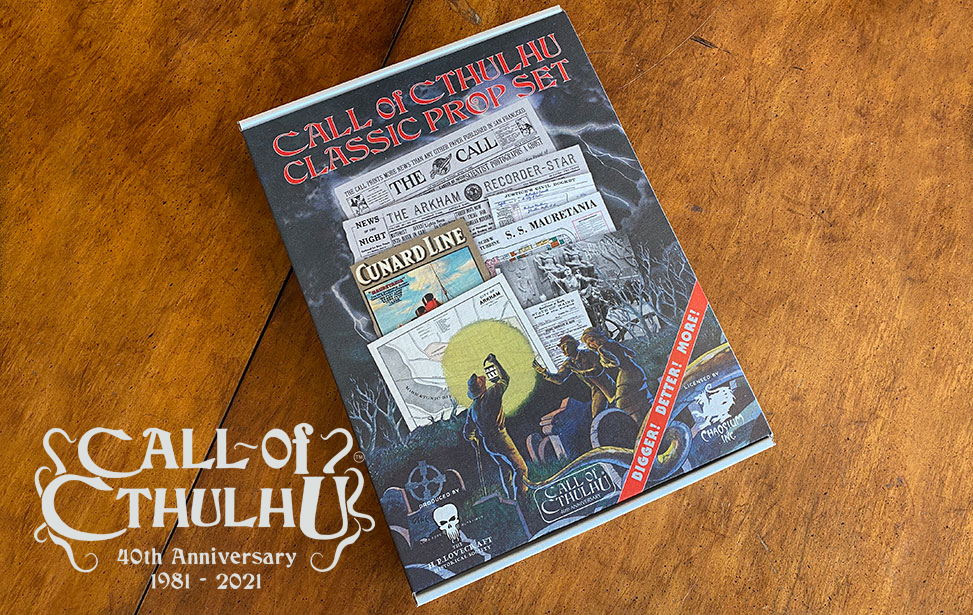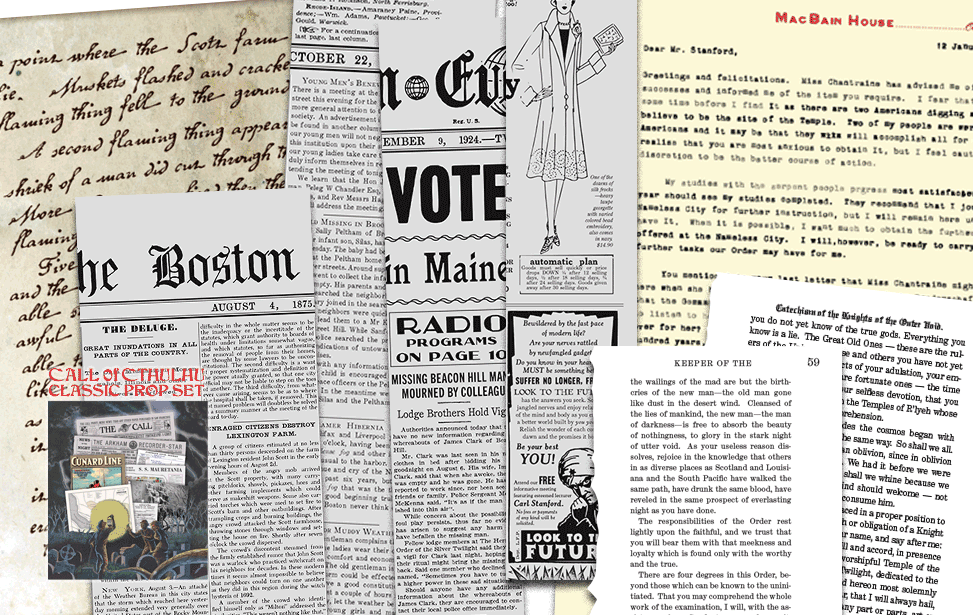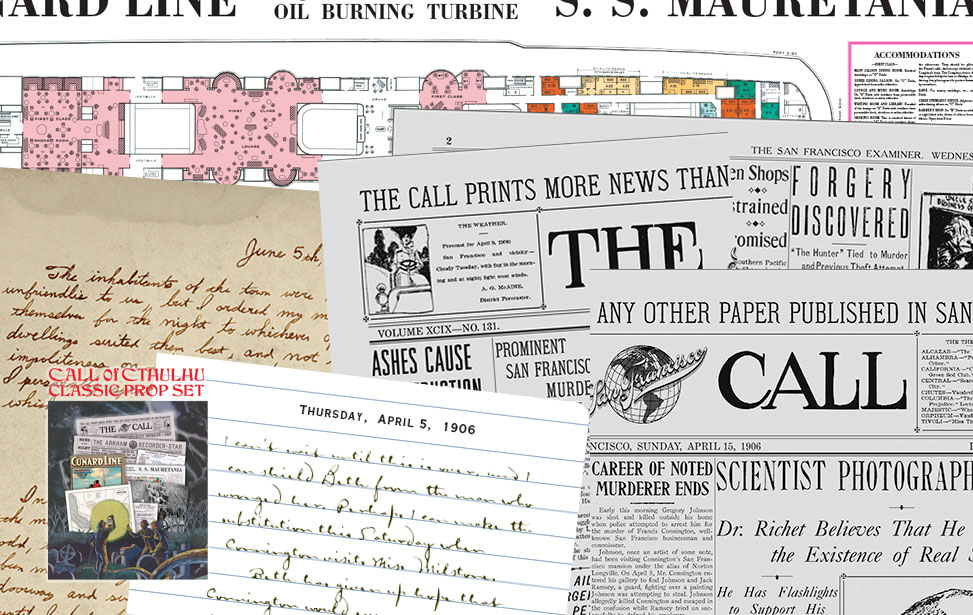Call of Cthulhu Classic Prop Set
Here you’ll find source material, inspirations, and other factoids that we hope will deepen your enjoyment of this very special HPLHS prop collection, and tips for Keepers to get the most use out of it.
The props are listed below in the sequence in which they are packed in the box. The set includes extra props not specifically required by Chaosium's texts, but which we thought would add to the fun. If you note that you are missing props in your set that are shown below, please do feel free to let us know and we'll do our best to replace them.
The Call of Cthulhu Classic Prop Set is produced under license from Chaosium Inc., and except where specifically noted otherwise is ©2022 by HPLHS Inc. All rights are reserved. Props are provided for gamers’ personal use in playing Chaosium’s fantastic role playing adventures. They may not be reproduced or redistributed without explicit permission.
The Props
 There are a total of 45 prop newspaper clippings in this collection, all contained in this broadsheet size newspaper for Keepers to cut apart as needed. Complete instructions for cutting out the clippings are provided within the newspaper itself, and in clipping guides contained in each folder. If you purchased the Clipmaster separately and don't have the clipping guides, you can download them here. The top half of the front page features instructions, and some stories about Call of Cthulhu itself, prop documents in general and the history of the HPLHS, but the rest of the paper is all prop clippings. In the drop-down panels below we'll show views of the clippings and provide a little more information about them.
There are a total of 45 prop newspaper clippings in this collection, all contained in this broadsheet size newspaper for Keepers to cut apart as needed. Complete instructions for cutting out the clippings are provided within the newspaper itself, and in clipping guides contained in each folder. If you purchased the Clipmaster separately and don't have the clipping guides, you can download them here. The top half of the front page features instructions, and some stories about Call of Cthulhu itself, prop documents in general and the history of the HPLHS, but the rest of the paper is all prop clippings. In the drop-down panels below we'll show views of the clippings and provide a little more information about them.
Please note: The clipmaster is printed like a real newspaper on a genuine high-speed offset web press. Due to the nature of that process, it is impossible to guarantee that the fronts and backs of the pages will line up perfectly every time. It’s actually pretty impressive they line up at all! It is possible that when you cut out a clipping, a small amount of material on the back will be lost. The best practice is to cut out the clippings by following the guides, to make sure that the relevant game clues are as complete as possible. A little missing information makes them more Lovecraftian! If your copy is way out of whack, please note the coupon on the front page which entitles you to a free replacement.
Here at HPLHS we are big believers in giving players more than just the directly relevant article. If we had our way, each one of these clippings would get an entire page of the newspaper, because we think it's most fun to let the players find the clues for themselves. Maybe they'll get a little sidetracked along the way, but it will always be interesting. As it turns out we couldn't make a 90-page newspaper, but we have made sure that each clipping is at least one full column, and some are an entire half page.
 The text of the game says only that some specific information is available in issues of the Boston Globe from 1835 and 1852, and an obituary for Walter Corbitt in 1866. It also says there is an "unpublished" article from 1920 about the "Haunted House". We decided to go ahead and make detailed clippings for all of those items. The real Boston Globe was not founded until 1871, so for surrounding matter in the older clippings we pulled genuine items from The Boston Post (1831–1956). Some of the information found in the clippings can also be found in a different form in the other prop documents for this game.
The text of the game says only that some specific information is available in issues of the Boston Globe from 1835 and 1852, and an obituary for Walter Corbitt in 1866. It also says there is an "unpublished" article from 1920 about the "Haunted House". We decided to go ahead and make detailed clippings for all of those items. The real Boston Globe was not founded until 1871, so for surrounding matter in the older clippings we pulled genuine items from The Boston Post (1831–1956). Some of the information found in the clippings can also be found in a different form in the other prop documents for this game.
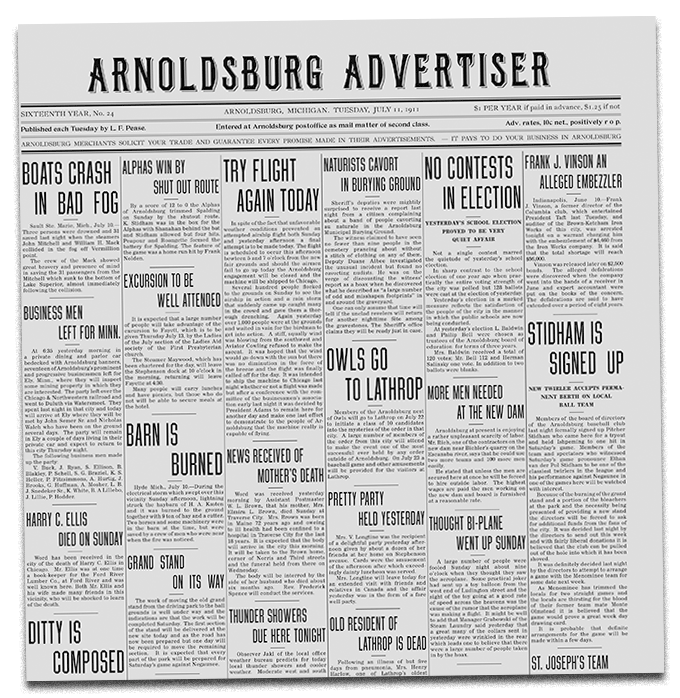 Arnoldsburg, Michigan is a fictional town, and the Arnoldsburg Advertiser is a made-up newspaper. We based it on real small-town U.P. Michigan newspapers of the period including the Escanaba Morning Press, which features lots of local pride in their baseball team, their businessmen, and their dairy products. Although the game-related article takes up only a small amount of space, we think the rest of the page is also a lot of fun. It features a number of obscure Easter eggs and shout-outs.
Arnoldsburg, Michigan is a fictional town, and the Arnoldsburg Advertiser is a made-up newspaper. We based it on real small-town U.P. Michigan newspapers of the period including the Escanaba Morning Press, which features lots of local pride in their baseball team, their businessmen, and their dairy products. Although the game-related article takes up only a small amount of space, we think the rest of the page is also a lot of fun. It features a number of obscure Easter eggs and shout-outs.
 These clippings are intended to be the path into the adventure for the investigators. The original supplement provides the text of the articles but does not specify a newspaper or a year: we had to pick something, so we chose the Albuquerque Journal of 1930. If that does not suit your campaign, you can always cut away the rest of the newspaper page and eliminate that context. The Journal is the largest newspaper in New Mexico, and went through several name changes before settling on this one in 1925.
These clippings are intended to be the path into the adventure for the investigators. The original supplement provides the text of the articles but does not specify a newspaper or a year: we had to pick something, so we chose the Albuquerque Journal of 1930. If that does not suit your campaign, you can always cut away the rest of the newspaper page and eliminate that context. The Journal is the largest newspaper in New Mexico, and went through several name changes before settling on this one in 1925.
 Winnemuck is another fictional town in Michigan's Upper Peninsula, and the Bee is another made-up newspaper. It is inspired by the Livingston Republican, published in Howell, Michigan, and by The Elkton Advance of Elkton, Michigan.
Winnemuck is another fictional town in Michigan's Upper Peninsula, and the Bee is another made-up newspaper. It is inspired by the Livingston Republican, published in Howell, Michigan, and by The Elkton Advance of Elkton, Michigan.
 These four clippings provide the clues identified as Investigator's Information items 4, 5, 6 and 7 in the game text. All are specified to be from issues of the Boston Globe spanning a period of decades, and we did take the liberty of adding a fair amount of detail.
These four clippings provide the clues identified as Investigator's Information items 4, 5, 6 and 7 in the game text. All are specified to be from issues of the Boston Globe spanning a period of decades, and we did take the liberty of adding a fair amount of detail.
 These two clippings are from British tabloid newspapers. The Daily Mail was founded in 1896 and still going strong today. It has always been one of Great Britain's most popular newspapers, known for conservative politics and sensational features. The game text specifies that the other newspaper should be the Sun, but since that newspaper didn't come into existence until 1964, we thought it would be more fun to use The Scoop, the fictional London tabloid created for another of Chaosium's classic games, Masks of Nyarlathotep. Surrounding matter for both clippings is adapted from contemporary issues of the Daily Mail and the Daily Mirror, another influential British tabloid of the day.
These two clippings are from British tabloid newspapers. The Daily Mail was founded in 1896 and still going strong today. It has always been one of Great Britain's most popular newspapers, known for conservative politics and sensational features. The game text specifies that the other newspaper should be the Sun, but since that newspaper didn't come into existence until 1964, we thought it would be more fun to use The Scoop, the fictional London tabloid created for another of Chaosium's classic games, Masks of Nyarlathotep. Surrounding matter for both clippings is adapted from contemporary issues of the Daily Mail and the Daily Mirror, another influential British tabloid of the day.
One of the surrounding articles talks about Frederick Albert Mitchell-Hedges, a notorious English adventurer of the period, who claimed, among other things, to have found a mystical crystal skull in British Honduras in 1924. Some say he was one of the inspirations for Indiana Jones.
 This clipping is just a small item, but because it's the only one from its time and place, it gets an entire half of a newspaper page to itself. The Los Angeles Globe Republican is a fictional newspaper, but the prop is based on the Los Angeles Times of 1899.
This clipping is just a small item, but because it's the only one from its time and place, it gets an entire half of a newspaper page to itself. The Los Angeles Globe Republican is a fictional newspaper, but the prop is based on the Los Angeles Times of 1899.
 These Boston Globe clippings are meant to be the path into the scenario for the investigators. Although they are mentioned only briefly in the game text, we thought it would be fun to provide the props so that Keepers can simply hand them to Investigators without comment and let events unfold from there.
These Boston Globe clippings are meant to be the path into the scenario for the investigators. Although they are mentioned only briefly in the game text, we thought it would be fun to provide the props so that Keepers can simply hand them to Investigators without comment and let events unfold from there.
 Confusingly, there is another scenario also entitled "The Madman" in the original Call of Cthulhu rule book, but there are no props for that scenario in this collection. These props go with the scenario in The Asylum and Other Tales. The town of Black Knob is fictional, and The Trumpet is a made-up newspaper. Our prop version is inspired by real small-town upstate New York newspapers including The Angola Record. According to that newspaper, Angola is "the town with GO in it," and we just couldn't pass up the chance to shoehorn that kind of sentiment into The Trumpet.
Confusingly, there is another scenario also entitled "The Madman" in the original Call of Cthulhu rule book, but there are no props for that scenario in this collection. These props go with the scenario in The Asylum and Other Tales. The town of Black Knob is fictional, and The Trumpet is a made-up newspaper. Our prop version is inspired by real small-town upstate New York newspapers including The Angola Record. According to that newspaper, Angola is "the town with GO in it," and we just couldn't pass up the chance to shoehorn that kind of sentiment into The Trumpet.
We were delighted by the story of the sea monster discovery that appears on the back side of one of these clippings, but dismayed that the image quality was very poor. Luckily, it was a syndicated item that ran in numerous papers nationwide during the same week, so we were able to find a better version of the photo in a different publication and used that instead. We were unable to find any follow-up to this story: presumably Elmer Garretson's discovery was suppressed by Cthulhu cultists....
 Although nowadays a town is lucky to have one newspaper, it is certainly true that many had multiple newspapers in the earlier decades of the 20th century, and this scenario gives us yet another one for Arkham to join the Gazette and the Advertiser. We were very happy for the chance to design a new Arkham newspaper, inspired by other real mid-size Massachusetts newspapers including The Berkshire Evening Eagle of Pittsfield. Eagle-eyed players may note the small item about the reservoir, which is of course the one which features in "The Colour Out of Space".
Although nowadays a town is lucky to have one newspaper, it is certainly true that many had multiple newspapers in the earlier decades of the 20th century, and this scenario gives us yet another one for Arkham to join the Gazette and the Advertiser. We were very happy for the chance to design a new Arkham newspaper, inspired by other real mid-size Massachusetts newspapers including The Berkshire Evening Eagle of Pittsfield. Eagle-eyed players may note the small item about the reservoir, which is of course the one which features in "The Colour Out of Space".
Some of the information in these clippings is available in a different form in the police reports.
 The text of these articles is from the game supplement, but we were at liberty to choose which specific San Francisco newspapers to use. Of course we could not resist using The Call for the 1906 items. (We were reminded that the great San Francisco earthquake occurred less than two weeks after an eruption of Mt. Vesuvius!) Founded in 1856, The Call was merged with several other newspapers and changed names a few times over the years, until it was taken over by the Examiner in 1965. For the 1922 article we chose the Examiner, which was the flagship of the Hearst publishing empire. Since there's only one article from that year, that clipping gets a whole half page to itself. Note the interesting, and completely real, article on the back about the mysterious scarab....
The text of these articles is from the game supplement, but we were at liberty to choose which specific San Francisco newspapers to use. Of course we could not resist using The Call for the 1906 items. (We were reminded that the great San Francisco earthquake occurred less than two weeks after an eruption of Mt. Vesuvius!) Founded in 1856, The Call was merged with several other newspapers and changed names a few times over the years, until it was taken over by the Examiner in 1965. For the 1922 article we chose the Examiner, which was the flagship of the Hearst publishing empire. Since there's only one article from that year, that clipping gets a whole half page to itself. Note the interesting, and completely real, article on the back about the mysterious scarab....
 This adventure starts when one of the Investigators receives one of these clippings. The Vancouver Daily Province is a real newspaper, published since 1894. It has changed its size and look over the years, and these clippings reflect the typographical changes of the real thing.
This adventure starts when one of the Investigators receives one of these clippings. The Vancouver Daily Province is a real newspaper, published since 1894. It has changed its size and look over the years, and these clippings reflect the typographical changes of the real thing.
There's a big ad for HP Sauce in this and in The Scoop. HP sauce is an iconic British condiment, and although of course we like those initials they actually stand for "Houses of Parliament". There is also an interesting article about Ruth Elder, a daring aviatrix of the 1920s who attempted to fly across the Atlantic a full ten years before Amelia Earhart's doomed solo attempt.
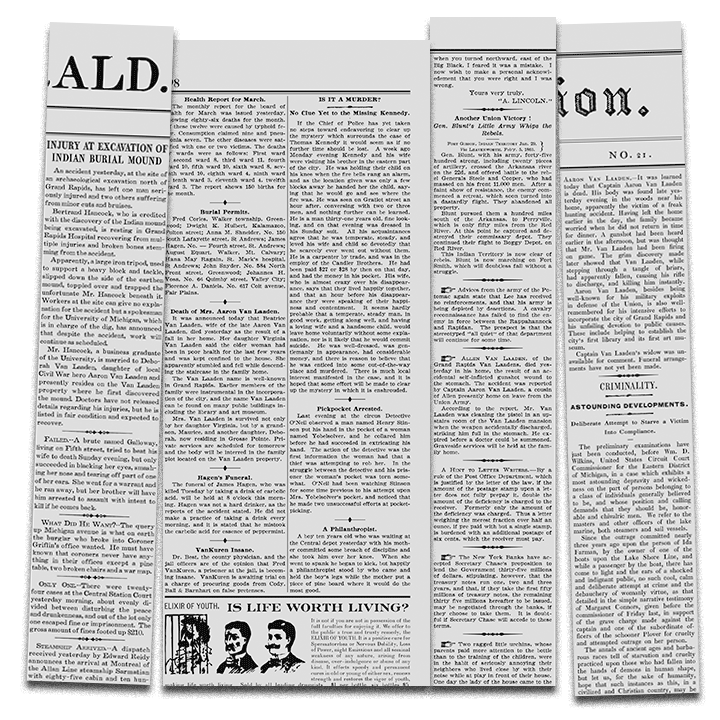 These four clippings are provided as specific clues in the game supplement. The Grand Rapids Herald was a real newspaper published between 1892 and 1959. The Kent Clarion is a fictional publication. The game text provides only years for these clippings, so we had to make some decisions about specific dates in order to provide surrounding matter for the clippings. Other news and ads were adapted from additional Michigan newspapers including the Constantine Republican, Detroit Free Press, East Saginaw Courier and Cass County Republican.
These four clippings are provided as specific clues in the game supplement. The Grand Rapids Herald was a real newspaper published between 1892 and 1959. The Kent Clarion is a fictional publication. The game text provides only years for these clippings, so we had to make some decisions about specific dates in order to provide surrounding matter for the clippings. Other news and ads were adapted from additional Michigan newspapers including the Constantine Republican, Detroit Free Press, East Saginaw Courier and Cass County Republican.
 All of these clippings are referred to in the game supplement, but no actual text was provided. We made some up, and hope that none of our additions create any irresolvable conflict. Some of the surrounding matter features stories about congressional violence, among other things, that we found rather haunting. Working on this Clipmaster was fun and fascinating, and really drove home the idea that history does indeed keep repeating itself....
All of these clippings are referred to in the game supplement, but no actual text was provided. We made some up, and hope that none of our additions create any irresolvable conflict. Some of the surrounding matter features stories about congressional violence, among other things, that we found rather haunting. Working on this Clipmaster was fun and fascinating, and really drove home the idea that history does indeed keep repeating itself....

 Because it is the only clipping from this particular year, this very small item gets an entire half page to itself. We were delighted to learn from the real Grand Rapids Herald about the Modern Woodmen of America, a fraternal benefit society that is still going strong. Unfortunately the accompanying photo was too low-resolution to use, but the name of the organization reminded us of our old friend Nick Offerman, so we took the liberty of compositing his image into an otherwise entirely real article about Major Mitchell. The real John Mitchell is pictured at right. All the other photos in that clipping are really of the people identified.
Because it is the only clipping from this particular year, this very small item gets an entire half page to itself. We were delighted to learn from the real Grand Rapids Herald about the Modern Woodmen of America, a fraternal benefit society that is still going strong. Unfortunately the accompanying photo was too low-resolution to use, but the name of the organization reminded us of our old friend Nick Offerman, so we took the liberty of compositing his image into an otherwise entirely real article about Major Mitchell. The real John Mitchell is pictured at right. All the other photos in that clipping are really of the people identified.
 If the Investigators look into civic records, they may find this probate document indicating that Reverend Michal Thomas is the executor of Corbitt's estate.
If the Investigators look into civic records, they may find this probate document indicating that Reverend Michal Thomas is the executor of Corbitt's estate.
 Investigators who look into Corbitt's dispute with his neighbors may find this page in the record books of the civil court, with details of their lawsuit trying to force him to move out. This prop was originally created when Sean Branney ran this adventure for game night at HPLHS headquarters.
Investigators who look into Corbitt's dispute with his neighbors may find this page in the record books of the civil court, with details of their lawsuit trying to force him to move out. This prop was originally created when Sean Branney ran this adventure for game night at HPLHS headquarters.
 At the police station, Investigators good at Law or Fast Talk might uncover this in-house memo which hints at official malfeasance and provides some details about the disappearance of Michael Thomas. The document is based on real police memos found in the case archives of the Sacco & Vanzetti trial.
At the police station, Investigators good at Law or Fast Talk might uncover this in-house memo which hints at official malfeasance and provides some details about the disappearance of Michael Thomas. The document is based on real police memos found in the case archives of the Sacco & Vanzetti trial.
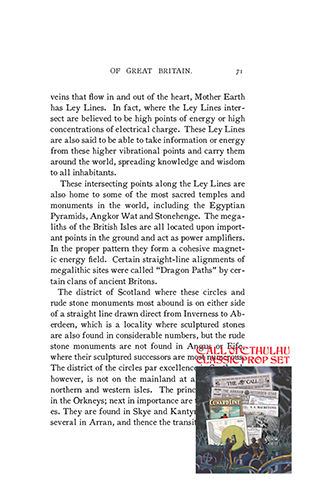 This scenario makes reference to huge amounts of letters, papers and books, but the numbers are so big and the descriptions are so general that it was impossible to make prop versions of all of those documents. We decided to provide two items that we hope will add to the fun. This is a page from The Standing Stones of Great Britain, a book that, as far as we could tell, doesn't actually exist. Our prop version is inspired by a real book called The Old Straight Track, written in 1925 by Alfred Watkins. It is one of the first books about ley lines.
This scenario makes reference to huge amounts of letters, papers and books, but the numbers are so big and the descriptions are so general that it was impossible to make prop versions of all of those documents. We decided to provide two items that we hope will add to the fun. This is a page from The Standing Stones of Great Britain, a book that, as far as we could tell, doesn't actually exist. Our prop version is inspired by a real book called The Old Straight Track, written in 1925 by Alfred Watkins. It is one of the first books about ley lines.
 This is a page from Von Junzt's infamous book which has some interesting information about lloigor, and mentions a Malcolm MacLaireag. This is the English-language version of this prop. Please note there is a German-language version of the very same page in Folder 2, for use in "The People of the Monolith". This one prop can be used in both games. You may wish to give your Investigators the German version first, and provide the English equivalent if/when they succeed in their Read German roll (presuming they need one).
This is a page from Von Junzt's infamous book which has some interesting information about lloigor, and mentions a Malcolm MacLaireag. This is the English-language version of this prop. Please note there is a German-language version of the very same page in Folder 2, for use in "The People of the Monolith". This one prop can be used in both games. You may wish to give your Investigators the German version first, and provide the English equivalent if/when they succeed in their Read German roll (presuming they need one).
 There were not a lot of prop documents called for by this scenario, but NPC Carol Cabot Walsingham does provide photos of Rogers Whittaker and his daughter Edith to the Investigators, so we thought we'd try to offer that one. We looked around for a vintage photo of a respectable State Department lawyer with a daughter, and found a 1924 picture of British Prime Minister Ramsay MacDonald and his daughter Joan. We then composited in the faces of Phillip Bell, co-founder of the HPLHS, and his daughter Zoë Ruha Bell.
There were not a lot of prop documents called for by this scenario, but NPC Carol Cabot Walsingham does provide photos of Rogers Whittaker and his daughter Edith to the Investigators, so we thought we'd try to offer that one. We looked around for a vintage photo of a respectable State Department lawyer with a daughter, and found a 1924 picture of British Prime Minister Ramsay MacDonald and his daughter Joan. We then composited in the faces of Phillip Bell, co-founder of the HPLHS, and his daughter Zoë Ruha Bell.
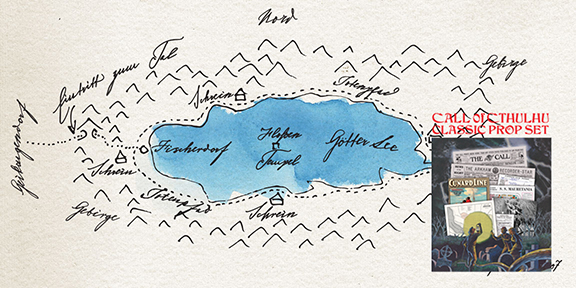 These prop documents are the starting point of the adventure, being found in an old book by the Investigators. This map is a color adaptation of the sketch map provided in the Chaosium supplement. Our German translator, Felix Salinger, did update some of the notations on the map.
These prop documents are the starting point of the adventure, being found in an old book by the Investigators. This map is a color adaptation of the sketch map provided in the Chaosium supplement. Our German translator, Felix Salinger, did update some of the notations on the map.

 The map is accompanied by a handwritten journal in German by Mannheim Dorfmann. We have provided this prop in both German and English. We recommend that Keepers who are running the game in English first give their players the German version. If they can't actually read German but succeed in their dice roll, then they can get the English version. The penmanship in this prop is based on the handwriting of Sigmund Freud.
The map is accompanied by a handwritten journal in German by Mannheim Dorfmann. We have provided this prop in both German and English. We recommend that Keepers who are running the game in English first give their players the German version. If they can't actually read German but succeed in their dice roll, then they can get the English version. The penmanship in this prop is based on the handwriting of Sigmund Freud.
 The Chaosium supplement features a detail map of part of the Belgian Congo, and we thought it would be fun to provide a large-format color version as a bonus for people who pre-ordered the prop set. This map is adapted from a map from 1949 drawn by Frans Laboulais. We took out some of the more modern elements, such as airline routes. We did not add any fictional locations to the map, leaving that up to Keepers.
The Chaosium supplement features a detail map of part of the Belgian Congo, and we thought it would be fun to provide a large-format color version as a bonus for people who pre-ordered the prop set. This map is adapted from a map from 1949 drawn by Frans Laboulais. We took out some of the more modern elements, such as airline routes. We did not add any fictional locations to the map, leaving that up to Keepers.
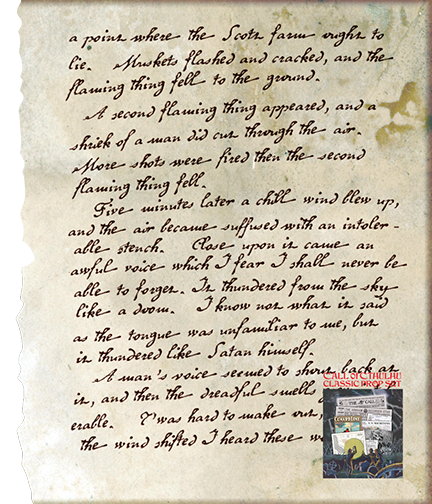 This item corresponds to "Information 3" in the game text, a slim volume from 1721 tucked away in the stacks of the Boston Public Library. We couldn't do the entire diary, but here is one particularly juicy page.
This item corresponds to "Information 3" in the game text, a slim volume from 1721 tucked away in the stacks of the Boston Public Library. We couldn't do the entire diary, but here is one particularly juicy page.
 This letter is to be found on the desktop in the study, in the first level of the caverns below the Lodge Hall of the Hermetic Order of the Silver Twilight.
This letter is to be found on the desktop in the study, in the first level of the caverns below the Lodge Hall of the Hermetic Order of the Silver Twilight.

 In the library on the third floor of the Lodge Hall, there are numerous books describing the rituals of the Hermetic Order of the Silver Twilight. We couldn't provide the entire books, but here is a page each from "Keeper of the Silver Gate" and "Catechism of the Knights of the Outer Void". Chaosium's supplement provides brief excerpts of the texts, and we have fleshed them out with material lifted from some 19th-century Masonic ritual books.
In the library on the third floor of the Lodge Hall, there are numerous books describing the rituals of the Hermetic Order of the Silver Twilight. We couldn't provide the entire books, but here is a page each from "Keeper of the Silver Gate" and "Catechism of the Knights of the Outer Void". Chaosium's supplement provides brief excerpts of the texts, and we have fleshed them out with material lifted from some 19th-century Masonic ritual books.
 This chapter of the campaign starts off with the receipt of this two-page letter. Normally a formal business letter would have a date and a salutation, but we have deliberately omitted them since we don't know the names of your Investigators.
This chapter of the campaign starts off with the receipt of this two-page letter. Normally a formal business letter would have a date and a salutation, but we have deliberately omitted them since we don't know the names of your Investigators.
 In the basement of the Look to the Future building there is a room full of futuristic machinery. If the Investigators figure out how to work it and type in a question about the Silver Twilight, the machine will print out this document. We originally wanted this prop to be really printed on a 1980s vintage dot-matrix tractor-feed printer, but we were unable to find a functioning one that was compatible with any of our own computers, so we designed this retro-futuristic substitute. It's funny to think that the 1980s are almost as far in the past for us today as the time period of this adventure is from the 1980s....
In the basement of the Look to the Future building there is a room full of futuristic machinery. If the Investigators figure out how to work it and type in a question about the Silver Twilight, the machine will print out this document. We originally wanted this prop to be really printed on a 1980s vintage dot-matrix tractor-feed printer, but we were unable to find a functioning one that was compatible with any of our own computers, so we designed this retro-futuristic substitute. It's funny to think that the 1980s are almost as far in the past for us today as the time period of this adventure is from the 1980s....
 Hidden in the podium in the Look to the Future building is a book entitled Old California. The game text provides a one-paragraph excerpt from the book, but otherwise not a lot of information. We based our prop page on Myths and Legends of California and the Old Southwest, compiled by Katharine Berry Judson in 1912.
Hidden in the podium in the Look to the Future building is a book entitled Old California. The game text provides a one-paragraph excerpt from the book, but otherwise not a lot of information. We based our prop page on Myths and Legends of California and the Old Southwest, compiled by Katharine Berry Judson in 1912.
 This chapter of the adventure starts when Jacob Hancock hires the Investigators to learn what is wrong with his uncle Henry, and provides copies of three letters. The first two are handwritten, and feature a code phrase referring to Jacob's father to indicate they are genuine. Our thanks to Dr. Jay Stigdon for providing the penmanship. The third is clumsily typewritten, and the signature doesn't appear to match, worrying poor Jacob.
This chapter of the adventure starts when Jacob Hancock hires the Investigators to learn what is wrong with his uncle Henry, and provides copies of three letters. The first two are handwritten, and feature a code phrase referring to Jacob's father to indicate they are genuine. Our thanks to Dr. Jay Stigdon for providing the penmanship. The third is clumsily typewritten, and the signature doesn't appear to match, worrying poor Jacob.
 In Henry Hancock's tent at the dig site, there is a copy of a page from Nameless Cults. We tried to think where he might have gotten such a thing, and decided that his nephew Jacob must have gone to Miskatonic University and gotten a Rectigraph made. The Rectigraph was the first photographic copying machine, invented around 1906 by George Beidler. It was a machine with a large camera that made a picture directly on a piece of photosensitive paper. This produces a negative image, so Rectigraph copies usually have a black background and white text. It takes special permission to get a Rectigraph from any of the books in the restricted collection at Orne Library....
In Henry Hancock's tent at the dig site, there is a copy of a page from Nameless Cults. We tried to think where he might have gotten such a thing, and decided that his nephew Jacob must have gone to Miskatonic University and gotten a Rectigraph made. The Rectigraph was the first photographic copying machine, invented around 1906 by George Beidler. It was a machine with a large camera that made a picture directly on a piece of photosensitive paper. This produces a negative image, so Rectigraph copies usually have a black background and white text. It takes special permission to get a Rectigraph from any of the books in the restricted collection at Orne Library....
 Perhaps not since How I Did It by Victor Frankenstein has there been such a bluntly informative prop as this simple list of names. We omitted the too-helpful title "Coven Members" in the hope of preserving a little mystery. The list is to be found fastened to the bottom of a battered chair in Duncan MacBain's cottage. Handwriting by Stephanie Morey.
Perhaps not since How I Did It by Victor Frankenstein has there been such a bluntly informative prop as this simple list of names. We omitted the too-helpful title "Coven Members" in the hope of preserving a little mystery. The list is to be found fastened to the bottom of a battered chair in Duncan MacBain's cottage. Handwriting by Stephanie Morey.
 This letter is also found fastened to the bottom of that chair in Duncan MacBain's cottage. For a powerful wizard he has a strange filing system, but then again he is an insane cultist. Thanks to Jon Szantos for the lovely handwriting.
This letter is also found fastened to the bottom of that chair in Duncan MacBain's cottage. For a powerful wizard he has a strange filing system, but then again he is an insane cultist. Thanks to Jon Szantos for the lovely handwriting.
 This prop is the first and most complete version of a manuscript that tells the story of an ancient Roman attempt to thwart the minions of the Outer Gods. It is to be found in the possession of Dr. Lorne MacParlan, an aged and nearly blind former physician and local expert on the folklore of Cannich.
This prop is the first and most complete version of a manuscript that tells the story of an ancient Roman attempt to thwart the minions of the Outer Gods. It is to be found in the possession of Dr. Lorne MacParlan, an aged and nearly blind former physician and local expert on the folklore of Cannich.
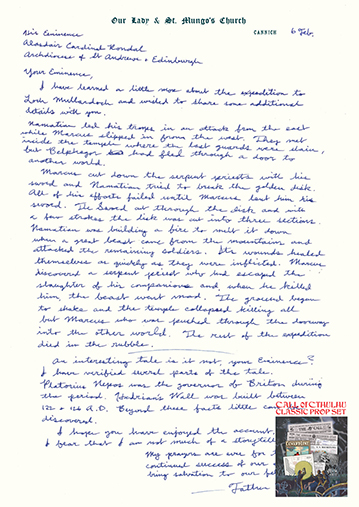 This prop is the second and least complete version of the story of the Loch Mullardoch expedition. It is to be found in the possession of Father Andrew MacBride, the Catholic priest of Cannich. Perhaps this is a first draft, or a personal copy, or perhaps Father MacBride wrote the letter but never actually sent it to Cardinal Rondal.
This prop is the second and least complete version of the story of the Loch Mullardoch expedition. It is to be found in the possession of Father Andrew MacBride, the Catholic priest of Cannich. Perhaps this is a first draft, or a personal copy, or perhaps Father MacBride wrote the letter but never actually sent it to Cardinal Rondal.
 This third version is a typewritten copy of the last part of Fr. MacBride's letter. Perhaps it was prepared by a church secretary and got separated from the preceding pages. Somehow it came into the hands of Andrew Kennedy, an archaeologist from Edinburgh who was a friend and colleague of Henry Hancock and Adam Chisholm. He is staying at the King's Head Inn in Cannich.
This third version is a typewritten copy of the last part of Fr. MacBride's letter. Perhaps it was prepared by a church secretary and got separated from the preceding pages. Somehow it came into the hands of Andrew Kennedy, an archaeologist from Edinburgh who was a friend and colleague of Henry Hancock and Adam Chisholm. He is staying at the King's Head Inn in Cannich.

 Since there are a couple of adventures set in Scotland in this collection, we thought it would be fun to provide a large-format vintage color map of the country for general use. Loch Mullardoch and the town of Cannich are real places, and although we haven't marked it on the map itself, it is circled in red on the thumbnail shown here so you can more easily point it out to your players if necessary. Loch Feinn and the town of Gregor are fictional, but based on the small map in Chaosium's supplement we have added it to the map and it is also circled in red on this thumbnail for easier reference. (Just click on the detail map at right to see a bigger version.)
Since there are a couple of adventures set in Scotland in this collection, we thought it would be fun to provide a large-format vintage color map of the country for general use. Loch Mullardoch and the town of Cannich are real places, and although we haven't marked it on the map itself, it is circled in red on the thumbnail shown here so you can more easily point it out to your players if necessary. Loch Feinn and the town of Gregor are fictional, but based on the small map in Chaosium's supplement we have added it to the map and it is also circled in red on this thumbnail for easier reference. (Just click on the detail map at right to see a bigger version.)
 This chapter of the campaign starts when the Investigators receive this letter from rich businessman and movie producer Grant Winwood. "Atlas" has been used as the name/trademark of a lot of different companies and products over the years, and this letterhead is inspired by the labelling on a vintage brand of spices produced by the Woolson Spice Company of Toledo and the 1920s letterhead of Metro-Goldwyn-Mayer.
This chapter of the campaign starts when the Investigators receive this letter from rich businessman and movie producer Grant Winwood. "Atlas" has been used as the name/trademark of a lot of different companies and products over the years, and this letterhead is inspired by the labelling on a vintage brand of spices produced by the Woolson Spice Company of Toledo and the 1920s letterhead of Metro-Goldwyn-Mayer.
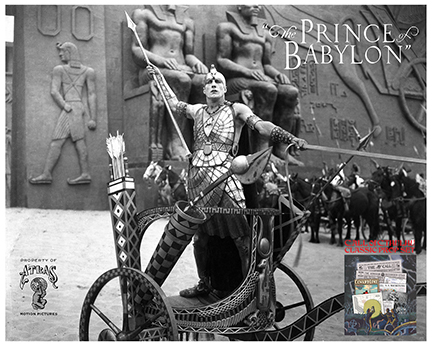 Although it's not really called for by the scenario, we could not pass up the opportunity to provide a still from Erich von Varnstein's doomed final motion picture, The Prince of Babylon. The photo is a real movie still from Cecil B. DeMille's first movie of The Ten Commandments, made in 1923 and featuring Charles De Roche as Rameses the Magnificent. Much like von Varnstein, DeMille built massive sets: DeMille's were in the middle of the Guadalupe-Nipomo Sand Dunes in Santa Barbara county south of San Francisco. After filming, the sets were left behind and consumed by the sand. They are still out there, and the ever-shifting winds occasionally reveal the face of a pharaoh.
Although it's not really called for by the scenario, we could not pass up the opportunity to provide a still from Erich von Varnstein's doomed final motion picture, The Prince of Babylon. The photo is a real movie still from Cecil B. DeMille's first movie of The Ten Commandments, made in 1923 and featuring Charles De Roche as Rameses the Magnificent. Much like von Varnstein, DeMille built massive sets: DeMille's were in the middle of the Guadalupe-Nipomo Sand Dunes in Santa Barbara county south of San Francisco. After filming, the sets were left behind and consumed by the sand. They are still out there, and the ever-shifting winds occasionally reveal the face of a pharaoh.

 This chapter of the adventure starts when the Investigators receive this letter. It comes with six pre-paid train tickets for the Investigators to travel to Portland, Maine. Since we don't know where your players will be coming from, there are blank spaces on the tickets for you to add the trip details by hand. You can use a standard hole punch to punch out the travel dates along the right side of each ticket, and the starting point on the left side. (If from Boston or New York, punch next to those pre-printed cities. If from some other point, write it down and punch accordingly.)
This chapter of the adventure starts when the Investigators receive this letter. It comes with six pre-paid train tickets for the Investigators to travel to Portland, Maine. Since we don't know where your players will be coming from, there are blank spaces on the tickets for you to add the trip details by hand. You can use a standard hole punch to punch out the travel dates along the right side of each ticket, and the starting point on the left side. (If from Boston or New York, punch next to those pre-printed cities. If from some other point, write it down and punch accordingly.)
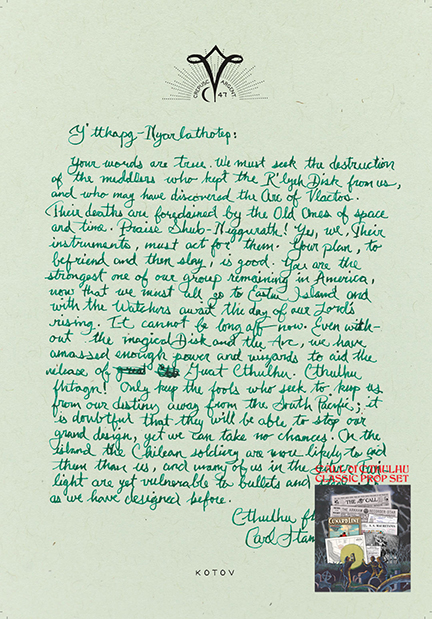 Any Investigators that make it through this section of the campaign will find this letter amongst Christopher Edwin's effects, at which point some things will make more sense. Handwriting by Jon Szantos.
Any Investigators that make it through this section of the campaign will find this letter amongst Christopher Edwin's effects, at which point some things will make more sense. Handwriting by Jon Szantos.
 This chapter of the adventure doesn't include any prop documents, but we did want to provide a large and full-color version of the map of the Island. This version was adapted from a French map engraved in 1877.
This chapter of the adventure doesn't include any prop documents, but we did want to provide a large and full-color version of the map of the Island. This version was adapted from a French map engraved in 1877.
 This chapter also does not call for prop documents. The game supplement does include a map of R'lyeh, but this is a handout, not a prop. It can only exist in the world of the players, not in the world of the characters. But we wanted to provide something for this chapter, so we decided to include a nautical chart showing the location of R'lyeh. This prop is a smaller version of the prop originally created for our movie The Call of Cthulhu. The full-size version is also included in an Angell Box.
This chapter also does not call for prop documents. The game supplement does include a map of R'lyeh, but this is a handout, not a prop. It can only exist in the world of the players, not in the world of the characters. But we wanted to provide something for this chapter, so we decided to include a nautical chart showing the location of R'lyeh. This prop is a smaller version of the prop originally created for our movie The Call of Cthulhu. The full-size version is also included in an Angell Box.
 Chaosium's supplement suggests this as one possible way for the Investigators to get into the adventure, and provides a brief paragraph of text. In order to flesh out an entire page, we drew on books about ancient monoliths throughout Europe. We thank HPLHS member Felix Salinger for translating it into 19th-century German.
Chaosium's supplement suggests this as one possible way for the Investigators to get into the adventure, and provides a brief paragraph of text. In order to flesh out an entire page, we drew on books about ancient monoliths throughout Europe. We thank HPLHS member Felix Salinger for translating it into 19th-century German.
 A number of the items on the list of clues were great candidates for prop document treatment. This item is Clue #2, a work order found in the office of Jerry Maklin which provides some revealing details about his last job. Thanks to friend of the HPLHS N.R. Jenzen-Jones for providing some fascinating information about the price of dynamite in the 1920s. The $637.60 shown on this work order would amount to almost $11,000 today.
A number of the items on the list of clues were great candidates for prop document treatment. This item is Clue #2, a work order found in the office of Jerry Maklin which provides some revealing details about his last job. Thanks to friend of the HPLHS N.R. Jenzen-Jones for providing some fascinating information about the price of dynamite in the 1920s. The $637.60 shown on this work order would amount to almost $11,000 today.
 This document is Clue #8. If the Investigators go to the Martin Adoption Agency and succeed in either debating or bribing a clerk, they may get access to this page from the adoption records of Jason Porter.
This document is Clue #8. If the Investigators go to the Martin Adoption Agency and succeed in either debating or bribing a clerk, they may get access to this page from the adoption records of Jason Porter.
 This document is Clue #3. If the Investigators go to the Hall of Records, they may find this page in a huge register of deeds, indicating that Jason Porter holds the deed to the Boucher estate.
This document is Clue #3. If the Investigators go to the Hall of Records, they may find this page in a huge register of deeds, indicating that Jason Porter holds the deed to the Boucher estate.
 This note can be found on a desk in one of the rubble-choked bedrooms of the Boucher house, near the unclothed skeleton of a man apparently trapped by the collapse of the roof. The lettering is based on the handwriting of H.P. Lovecraft.
This note can be found on a desk in one of the rubble-choked bedrooms of the Boucher house, near the unclothed skeleton of a man apparently trapped by the collapse of the roof. The lettering is based on the handwriting of H.P. Lovecraft.
 We have substantially beefed up the catalog from Chaosium's original handout, adding text in both French and German (thanks to Sophie Klesen and Felix Salinger). We have also added photos of some of the lots. Although Lot #9, The Brazen Head, is the one with the most gaming potential, we wanted to provide pictures of others as well so as not to give away too much to the Investigators. The photo is actually a 3D rendering of a digital model created by our friends at Type40, based on the original Tom Sullivan illustration in the Chaosium supplement.
We have substantially beefed up the catalog from Chaosium's original handout, adding text in both French and German (thanks to Sophie Klesen and Felix Salinger). We have also added photos of some of the lots. Although Lot #9, The Brazen Head, is the one with the most gaming potential, we wanted to provide pictures of others as well so as not to give away too much to the Investigators. The photo is actually a 3D rendering of a digital model created by our friends at Type40, based on the original Tom Sullivan illustration in the Chaosium supplement.
In an ideal world, everyone who attends the auction would get their own copy of the catalog to study and make notes in. Since we don't know how many players you might have, we have provided two copies with this prop set. If you need more, you can purchase additional copies a la carte in our online store.
 Although it isn't specifically required by the game, we wanted to provide a nice large-format period map of Austria. This one comes from The Citizen's Atlas of the World, edited by John Bartholomew in 1924.
Although it isn't specifically required by the game, we wanted to provide a nice large-format period map of Austria. This one comes from The Citizen's Atlas of the World, edited by John Bartholomew in 1924.
 The receipt of this letter and its several enclosures is the starting point for this adventure.
The receipt of this letter and its several enclosures is the starting point for this adventure.
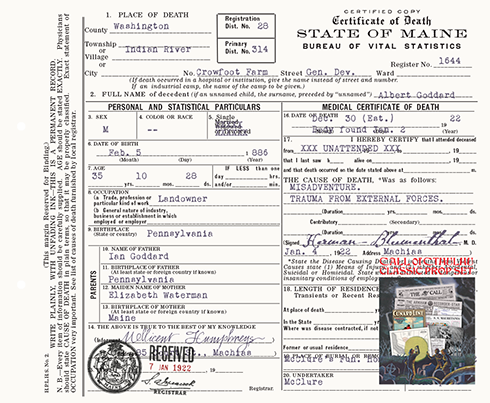 This is an official copy of Albert Goddard's death certificate. It reveals a number of additional details about Goddard and the circumstances of his death.
This is an official copy of Albert Goddard's death certificate. It reveals a number of additional details about Goddard and the circumstances of his death.
 To be honest, even after doing a fair amount of research, we're still not entirely sure what a "Bill of Holding" is, but we think it's part of the legal paperwork required for a mortuary to hold onto someone's remains until they are collected by his/her estate/executors. This prop is based on similar paperwork, a permit to transport a corpse. This one is stamped "Pending" because it is up to the Investigator who is Albert Goddard's brother to indicate where the body is going to be buried, at which time the mortuary director and the coroner can sign the form and finalize the arrangements.
To be honest, even after doing a fair amount of research, we're still not entirely sure what a "Bill of Holding" is, but we think it's part of the legal paperwork required for a mortuary to hold onto someone's remains until they are collected by his/her estate/executors. This prop is based on similar paperwork, a permit to transport a corpse. This one is stamped "Pending" because it is up to the Investigator who is Albert Goddard's brother to indicate where the body is going to be buried, at which time the mortuary director and the coroner can sign the form and finalize the arrangements.
 This bill for services from Horace Cobb's firm amounts to a little more than $800 in today's money.
This bill for services from Horace Cobb's firm amounts to a little more than $800 in today's money.
 There are several different kinds of deeds, and as we are not ourselves real estate lawyers we can't say if this is the most legally appropriate document, but it is based on real vintage deeds and serves the much more important storytelling function of providing details about the Waterman family property and its history.
There are several different kinds of deeds, and as we are not ourselves real estate lawyers we can't say if this is the most legally appropriate document, but it is based on real vintage deeds and serves the much more important storytelling function of providing details about the Waterman family property and its history.
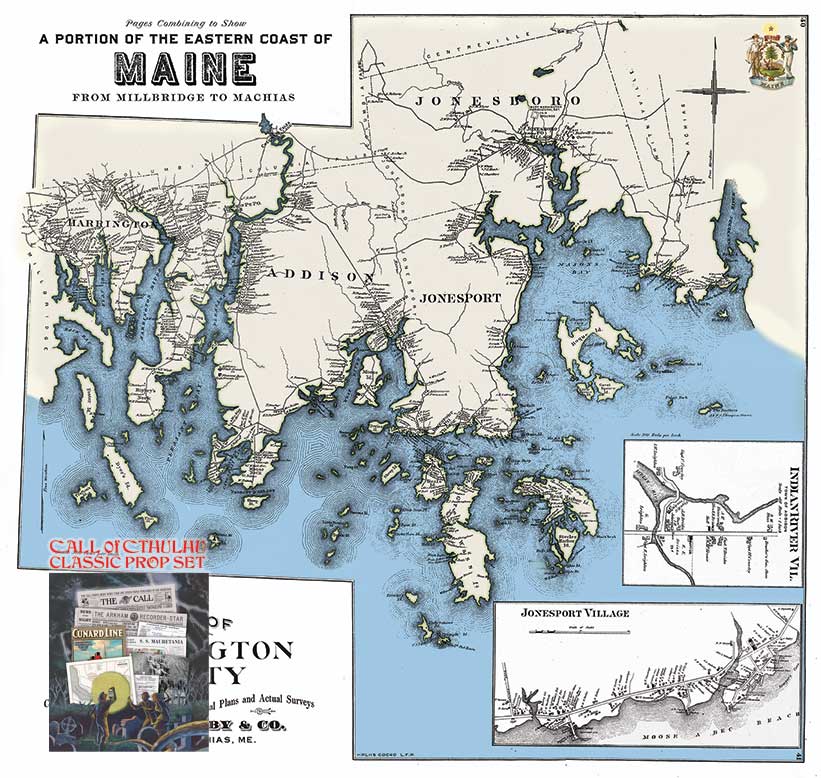
 We wanted to provide a nice, large-format color map of Maine, and looked at a number of vintage options. In the end we opted for this composite map, featuring three different maps stitched together from George Colby's 1881 Atlas of Washington County (thanks, eBay!), to provide the most detailed possible view of the area of Maine where the story takes place. We have added Horace Cobb's office location to the inset map of Jonesport Village, and Drucker's General Store to the inset of Indian River Village. The location of Black Devil Mountain and the Crowfoot Farm property are circled in red on this detail for Keeper reference. (Click on the detail to see an enlarged view.)
We wanted to provide a nice, large-format color map of Maine, and looked at a number of vintage options. In the end we opted for this composite map, featuring three different maps stitched together from George Colby's 1881 Atlas of Washington County (thanks, eBay!), to provide the most detailed possible view of the area of Maine where the story takes place. We have added Horace Cobb's office location to the inset map of Jonesport Village, and Drucker's General Store to the inset of Indian River Village. The location of Black Devil Mountain and the Crowfoot Farm property are circled in red on this detail for Keeper reference. (Click on the detail to see an enlarged view.)
 The text of this unfinished letter is from the Chaosium supplement. The penmanship is by Timothy Birrell.
The text of this unfinished letter is from the Chaosium supplement. The penmanship is by Timothy Birrell.
 This diary is to be found in the Greenwood town library, buried at the bottom of a stack of old books. Our thanks to Eric Hehl for his penmanship skills.
This diary is to be found in the Greenwood town library, buried at the bottom of a stack of old books. Our thanks to Eric Hehl for his penmanship skills.
 Having done a large-format brochure for the Cunard Line for our Brotherhood of the Beast Deluxe Edition, now out of print, we knew we had to include this modified version in this collection. It is based on a couple of different real travel brochures of the 1920s.
Having done a large-format brochure for the Cunard Line for our Brotherhood of the Beast Deluxe Edition, now out of print, we knew we had to include this modified version in this collection. It is based on a couple of different real travel brochures of the 1920s.
 A lot of police work is paperwork, and every time an officer takes a statement or makes a report, forms like these get filled out. These are based on old movie prop versions of "DD5"s, which is supposedly code or slang for "Detective Documents". These forms contain additional information about the incidents which were reported in the newspaper about strange goings-on in the Old Wooded Graveyard.
A lot of police work is paperwork, and every time an officer takes a statement or makes a report, forms like these get filled out. These are based on old movie prop versions of "DD5"s, which is supposedly code or slang for "Detective Documents". These forms contain additional information about the incidents which were reported in the newspaper about strange goings-on in the Old Wooded Graveyard.
 We wanted to provide a new version of the canonical Chaosium map of Arkham, and we are very grateful to Chaosium for giving us permission to take it on. This map is done in the style of late-19th-century atlases. It will be useful not only for this game but for any Chaosium game taking place in Arkham.
We wanted to provide a new version of the canonical Chaosium map of Arkham, and we are very grateful to Chaosium for giving us permission to take it on. This map is done in the style of late-19th-century atlases. It will be useful not only for this game but for any Chaosium game taking place in Arkham.
 This page fell out of Gregory Johnson's diary and was left behind in the hidden Zeus room in the Westchester house.
This page fell out of Gregory Johnson's diary and was left behind in the hidden Zeus room in the Westchester house.
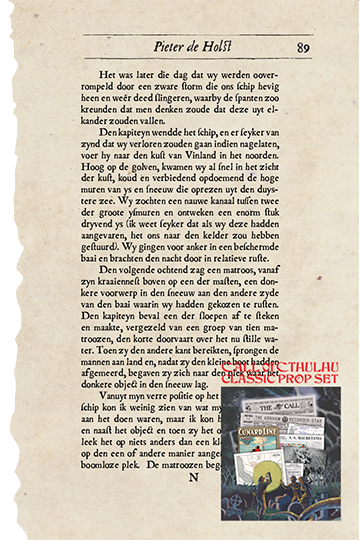
 The Investigators may discover this journal from 1540 in the library of the seminary in Godthab. It is a slim volume in poor condition, and most of it is mundane except for this section. The journal is in the Dutch language, thanks to HPLHS Member Andries Munnik. We have also provided the English version for those who make a successful "Read Dutch" roll.
The Investigators may discover this journal from 1540 in the library of the seminary in Godthab. It is a slim volume in poor condition, and most of it is mundane except for this section. The journal is in the Dutch language, thanks to HPLHS Member Andries Munnik. We have also provided the English version for those who make a successful "Read Dutch" roll.
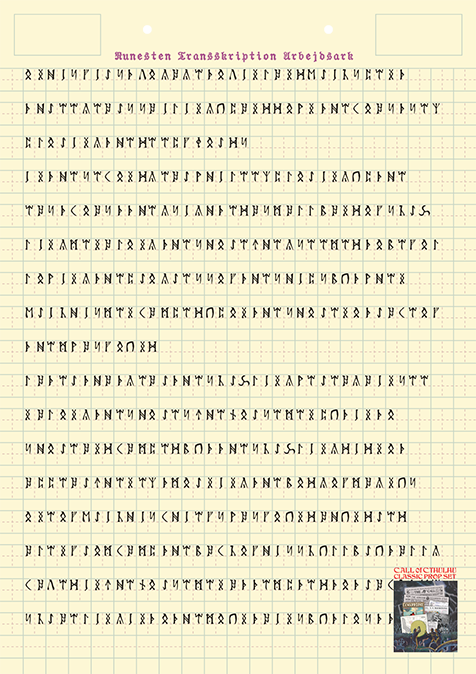 A stone at Nels Petersen's Viking village site features an inscription in runes. We could not provide the actual stone, so we are providing this set of worksheets that Nels Petersen has made to assist in deciphering the story. There are three sections of the stone. Petersen has found and already deciphered two of them. This is the remaining undeciphered section. The Investigators can use the two completed worksheets as a key to decipher this one. The plaintext version is in Chaosium's supplement if they need any hints.
A stone at Nels Petersen's Viking village site features an inscription in runes. We could not provide the actual stone, so we are providing this set of worksheets that Nels Petersen has made to assist in deciphering the story. There are three sections of the stone. Petersen has found and already deciphered two of them. This is the remaining undeciphered section. The Investigators can use the two completed worksheets as a key to decipher this one. The plaintext version is in Chaosium's supplement if they need any hints.
 This is the first already-completed section of the runic inscription.
This is the first already-completed section of the runic inscription.
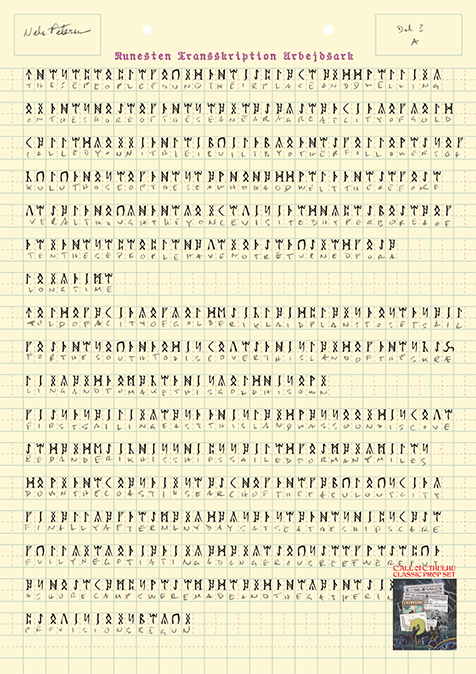 This is the other previously-completed section. Once the Investigators have all three sections deciphered, it will be up to them to put the pieces of the story in the right order.
This is the other previously-completed section. Once the Investigators have all three sections deciphered, it will be up to them to put the pieces of the story in the right order.
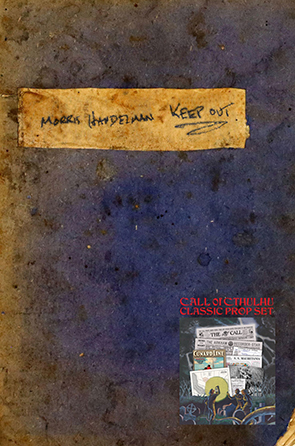 Among the disturbing discoveries in the cabin at Murtle Lake is Morris Handelman's notebook. It is thickly coated with frost, which, along with Handelman's insane handwriting, makes it very difficult to read. The full notebook documents a ten-year effort to capture a sasquatch, and the other pages reveal that Handelman and his partner had no scientific interest in their quarry, and wanted only to exhibit one for profit. We recommend letting your players struggle to read this prop, but the text is clearly presented in Chaosium's supplement if you wish to help them out.
Among the disturbing discoveries in the cabin at Murtle Lake is Morris Handelman's notebook. It is thickly coated with frost, which, along with Handelman's insane handwriting, makes it very difficult to read. The full notebook documents a ten-year effort to capture a sasquatch, and the other pages reveal that Handelman and his partner had no scientific interest in their quarry, and wanted only to exhibit one for profit. We recommend letting your players struggle to read this prop, but the text is clearly presented in Chaosium's supplement if you wish to help them out.
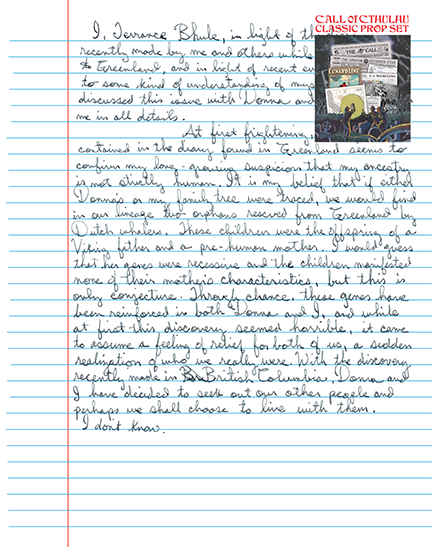 Terrence Bhule kept a journal starting after the announcement of the discovery of a sasquatch specimen in Vancouver, but none of the entries are dated. This prop consists of a couple of pages, separated by an unknown amount of time. Bhule's notebook is among a small library of books to be found in the smaller of a set of dens found in a secluded valley near Murtle Lake. Handwriting by stalwart HPLHS member Dr. Jay Stigdon.
Terrence Bhule kept a journal starting after the announcement of the discovery of a sasquatch specimen in Vancouver, but none of the entries are dated. This prop consists of a couple of pages, separated by an unknown amount of time. Bhule's notebook is among a small library of books to be found in the smaller of a set of dens found in a secluded valley near Murtle Lake. Handwriting by stalwart HPLHS member Dr. Jay Stigdon.
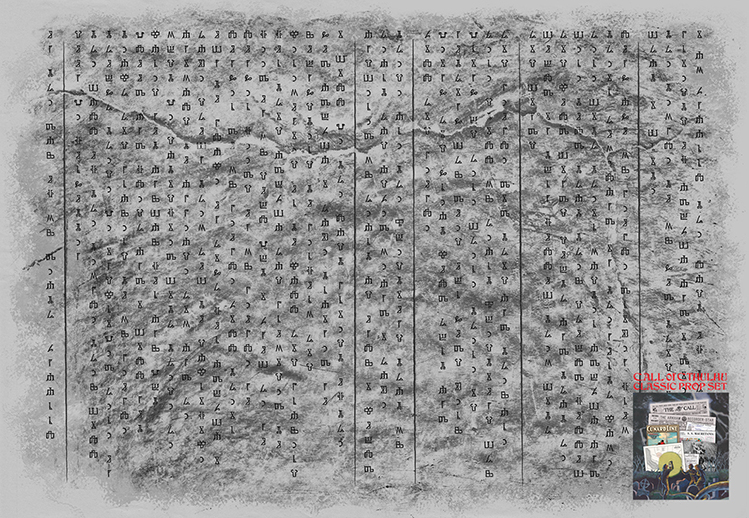 Hidden in a small chamber deep within the sasquatch den of Terrence Bhule, there is an inscription in strange glyphs carved into stone. We could not provide the stone, so we are providing this rubbing of the inscription for the Investigators to decipher. Nels Peteresen is not here to help them this time, so they are on their own to figure out what it says. They are written in Voormic glyphs, and should be read from right to left, from top to bottom. There are no punctuation marks. The plaintext version is in the Chaosium supplement, but if you click on the image shown here, you will see a deciphered version in case you want to help your players out.
Hidden in a small chamber deep within the sasquatch den of Terrence Bhule, there is an inscription in strange glyphs carved into stone. We could not provide the stone, so we are providing this rubbing of the inscription for the Investigators to decipher. Nels Peteresen is not here to help them this time, so they are on their own to figure out what it says. They are written in Voormic glyphs, and should be read from right to left, from top to bottom. There are no punctuation marks. The plaintext version is in the Chaosium supplement, but if you click on the image shown here, you will see a deciphered version in case you want to help your players out.
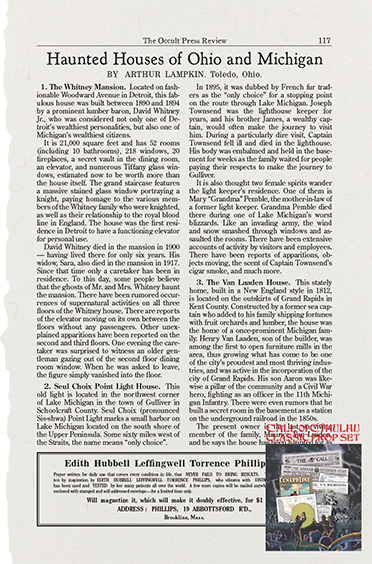 This article is offered as a way to kick off the adventure, and provides the first of many red herrings. Six houses are mentioned, and the Investigators might well be intrigued by any of them, but of course the game is about the Van Laaden house so it is hoped the mention of a potential monetary reward will steer them in that direction. The other five locations mentioned in the article are real sites, although whether or not they are really haunted is not for us to say.
This article is offered as a way to kick off the adventure, and provides the first of many red herrings. Six houses are mentioned, and the Investigators might well be intrigued by any of them, but of course the game is about the Van Laaden house so it is hoped the mention of a potential monetary reward will steer them in that direction. The other five locations mentioned in the article are real sites, although whether or not they are really haunted is not for us to say.
 We could not resist providing the eight-page ghostbusting contract that Maurice Van Laaden requires the Investigators to sign. There are a number of blank spaces where the Investigators and Maurice must sign their names, and we hope it provides for some fun role-playing. Our thanks to the HPLHS' consulting attorney, Sherry Spees, for providing us with some boilerplate language to use as a starting point.
We could not resist providing the eight-page ghostbusting contract that Maurice Van Laaden requires the Investigators to sign. There are a number of blank spaces where the Investigators and Maurice must sign their names, and we hope it provides for some fun role-playing. Our thanks to the HPLHS' consulting attorney, Sherry Spees, for providing us with some boilerplate language to use as a starting point.

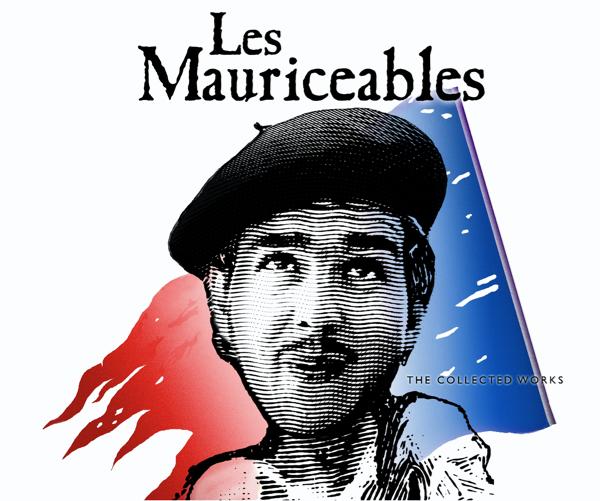 When we ourselves played this game back in the day, Sean Branney played Maurice Van Laaden as an extremely flaky NPC, and he wrote a few actual poems meant to be so bad they were good. It was highly entertaining. Some time later, when Branney was attending graduate school at the California Institute of the Arts, the Maurice character took on a life of his own, dropping the name "Van Laaden" and becoming known simply as Maurice. Branney wrote a lot more Maurice poems, and his fellow art and theatre students joined in the fun, setting some of the verses to music, staging photo shoots and live readings, and more. Eventually there were enough Maurice poems and photos to fill an entire book, Les Mauriceables. We could not resist the opportunity to share some of these metrical treasures, so we have taken some of these poems and recast them in the style of The Poetical Works of Jonathan E. Hoag, a book that H.P. Lovecraft edited and wrote a preface for in 1923. All of the poems in this book are by Branney/Maurice, except for "The Celtic's Dream of his Erin Home", which is actually by Hoag.
When we ourselves played this game back in the day, Sean Branney played Maurice Van Laaden as an extremely flaky NPC, and he wrote a few actual poems meant to be so bad they were good. It was highly entertaining. Some time later, when Branney was attending graduate school at the California Institute of the Arts, the Maurice character took on a life of his own, dropping the name "Van Laaden" and becoming known simply as Maurice. Branney wrote a lot more Maurice poems, and his fellow art and theatre students joined in the fun, setting some of the verses to music, staging photo shoots and live readings, and more. Eventually there were enough Maurice poems and photos to fill an entire book, Les Mauriceables. We could not resist the opportunity to share some of these metrical treasures, so we have taken some of these poems and recast them in the style of The Poetical Works of Jonathan E. Hoag, a book that H.P. Lovecraft edited and wrote a preface for in 1923. All of the poems in this book are by Branney/Maurice, except for "The Celtic's Dream of his Erin Home", which is actually by Hoag.
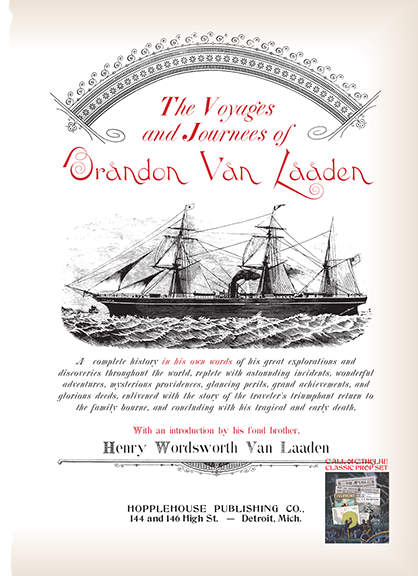 There are two copies of this book to be found during the adventure. The first is in the rare book section of the local public library, and the second is in the Van Laaden home library. We have provided the first few pages of the book including a very elaborate table of contents typical of Victorian-era publishing, which conveniently summarizes each chapter.
There are two copies of this book to be found during the adventure. The first is in the rare book section of the local public library, and the second is in the Van Laaden home library. We have provided the first few pages of the book including a very elaborate table of contents typical of Victorian-era publishing, which conveniently summarizes each chapter.
 The old roll-top desk in the study on the first floor of the Van Laaden mansion contains family business records dating back 100 years. This letter is among the many papers to be found there.
The old roll-top desk in the study on the first floor of the Van Laaden mansion contains family business records dating back 100 years. This letter is among the many papers to be found there.
 This letter is another of the many papers found in the roll-top desk.
This letter is another of the many papers found in the roll-top desk.
 Also in the desk is the journal of Aaron Van Laaden, kept from early 1853 until he went off to fight in the Civil War. The book is in poor condition, and this page practically falls out if the volume is handled.
Also in the desk is the journal of Aaron Van Laaden, kept from early 1853 until he went off to fight in the Civil War. The book is in poor condition, and this page practically falls out if the volume is handled.
 In the library of the Van Laaden mansion is to be found the family bible. If an Investigator looks through it, she will find this sad note from Elizabeth Van Laaden, placed there by her grieving parents.
In the library of the Van Laaden mansion is to be found the family bible. If an Investigator looks through it, she will find this sad note from Elizabeth Van Laaden, placed there by her grieving parents.
 In the dusty, neglected bedroom of Erich Van Laaden on the second floor of the mansion, the Investigators may find an old sea chest. If they succeed in picking the lock or prying it open they will find, among other interesting things, the log of the ship Tanager. We have provided four key pages from the log.
In the dusty, neglected bedroom of Erich Van Laaden on the second floor of the mansion, the Investigators may find an old sea chest. If they succeed in picking the lock or prying it open they will find, among other interesting things, the log of the ship Tanager. We have provided four key pages from the log.
 In the master bedroom on the second floor of the Van Laaden mansion, the Investigators may find the diary of Virginia Van Laaden in the nightstand. The diary was kept only intermittently, and we have provided two entries which happen to be on opposite sides of the same leaf.
In the master bedroom on the second floor of the Van Laaden mansion, the Investigators may find the diary of Virginia Van Laaden in the nightstand. The diary was kept only intermittently, and we have provided two entries which happen to be on opposite sides of the same leaf.
 In the second-floor study of the mansion there is a large desk. The top drawer contains, among other things, this letter.
In the second-floor study of the mansion there is a large desk. The top drawer contains, among other things, this letter.
 Also in the desk drawer is the journal of Bernard Hancock, Aaron Van Laaden's son-in-law, who lived in the house before moving to Detroit in 1880. Bernard fancied himself a scientist and noted various natural phenomena he observed from time to time. We have provided two non-contiguous pages from the book.
Also in the desk drawer is the journal of Bernard Hancock, Aaron Van Laaden's son-in-law, who lived in the house before moving to Detroit in 1880. Bernard fancied himself a scientist and noted various natural phenomena he observed from time to time. We have provided two non-contiguous pages from the book.
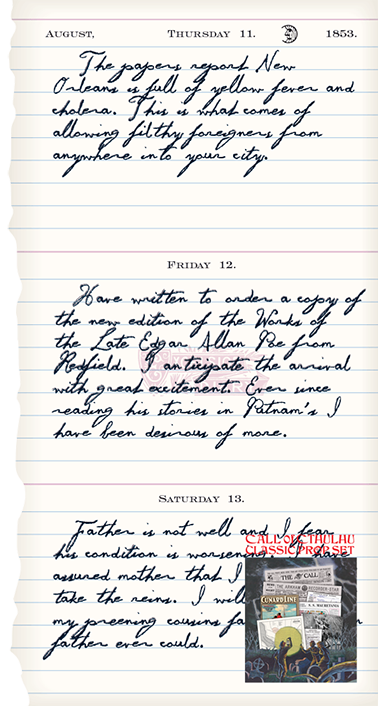 This book can be found behind a secret panel of the desk in the third-floor library. It was kept secretly by Allen Van Laaden from 1853 until his death, and is quite lengthy. We have provided nine particularly interesting pages.
This book can be found behind a secret panel of the desk in the third-floor library. It was kept secretly by Allen Van Laaden from 1853 until his death, and is quite lengthy. We have provided nine particularly interesting pages.
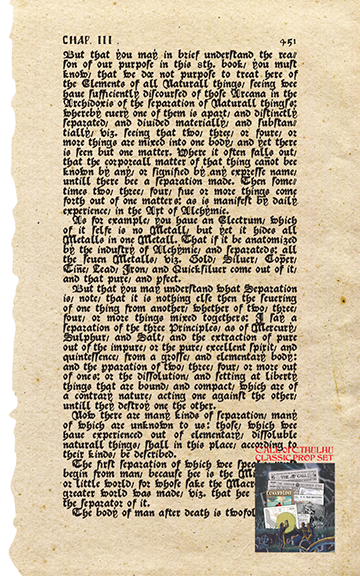 This mysterious book is found alongside Allen's diary in the hidden compartment of the desk. It has no title or date, but is presumably one of the strange books collected by Brandon Van Laaden during his voyages. It claims to be a study of necromancy taken from a "Book of the Dead" that originated in either ancient Persia or Afghanistan. The text is inspired by A New Light of Alchymie: Of the Nature of Things, Book Eight, 1650. The "Summon Ghost" spell is provided as a footnote.
This mysterious book is found alongside Allen's diary in the hidden compartment of the desk. It has no title or date, but is presumably one of the strange books collected by Brandon Van Laaden during his voyages. It claims to be a study of necromancy taken from a "Book of the Dead" that originated in either ancient Persia or Afghanistan. The text is inspired by A New Light of Alchymie: Of the Nature of Things, Book Eight, 1650. The "Summon Ghost" spell is provided as a footnote.
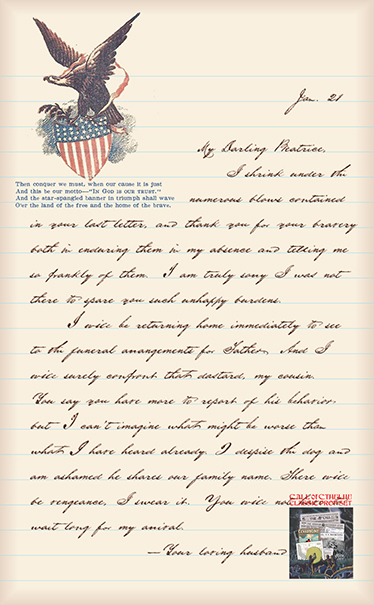 In Beatrice's bedrooom on the third floor of the mansion can be found a bundle of old letters from her husband Aaron, tied with a faded blue ribbon. We could not provide an entire bundle of letters, but here is one of particular interest, written from the front lines of the Civil War on some notepaper that was sold to soldiers so they could send messages back home. The notepaper is based on samples in the Library of Congress.
In Beatrice's bedrooom on the third floor of the mansion can be found a bundle of old letters from her husband Aaron, tied with a faded blue ribbon. We could not provide an entire bundle of letters, but here is one of particular interest, written from the front lines of the Civil War on some notepaper that was sold to soldiers so they could send messages back home. The notepaper is based on samples in the Library of Congress.
 Tucked between the mattresses of the bed last used by Beatrice is another slim volume. It is Beatrice's diary and reveals little more than that she has gone completely insane. We have provided one sample page. Creepy doodles by Darrell Tutchton.
Tucked between the mattresses of the bed last used by Beatrice is another slim volume. It is Beatrice's diary and reveals little more than that she has gone completely insane. We have provided one sample page. Creepy doodles by Darrell Tutchton.
 After returning home from the war, Aaron kept a new diary until his self-inflicted death in 1866. His widow Beatrice placed it in a storage room on the third floor along with other belongings. We have provided four non-contiguous pages.
After returning home from the war, Aaron kept a new diary until his self-inflicted death in 1866. His widow Beatrice placed it in a storage room on the third floor along with other belongings. We have provided four non-contiguous pages.
 This letter is the only item of interest to be found in the cramped and crowded attic of the Van Laaden mansion. It was written in 1826 to Mary Gottler, shortly after her wedding to David Dugan Van Laaden, by her fanatically devout Catholic mother. We omitted the signature because it seemed odd to us for a mother to formally sign a letter to her own daughter, so the Investigators might have to use context to figure out who this is from.
This letter is the only item of interest to be found in the cramped and crowded attic of the Van Laaden mansion. It was written in 1826 to Mary Gottler, shortly after her wedding to David Dugan Van Laaden, by her fanatically devout Catholic mother. We omitted the signature because it seemed odd to us for a mother to formally sign a letter to her own daughter, so the Investigators might have to use context to figure out who this is from.
 There are numerous boxes of papers stored in the basement of the Van Laaden mansion, and this old letter from the Kent County coroner is to be found there.
There are numerous boxes of papers stored in the basement of the Van Laaden mansion, and this old letter from the Kent County coroner is to be found there.
 This official report is to be found associated with the letter seen above.
This official report is to be found associated with the letter seen above.
We are hard at work on completing this website. Please check back soon.

